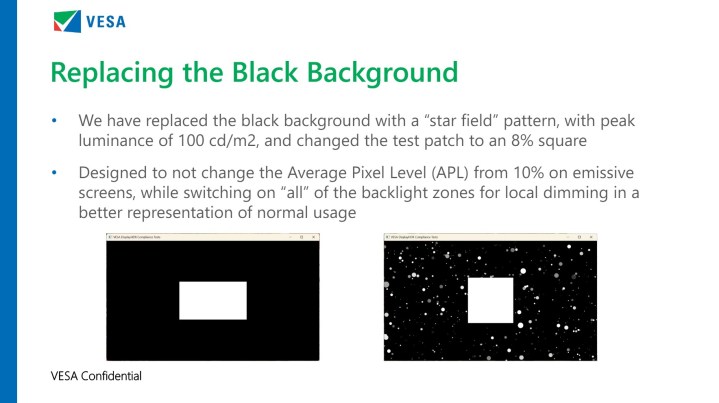
HDR is about to get a big upgrade on PC. The Video Electronics Standards Association (VESA), the nonprofit group behind standards like DisplayPort and Adaptive Sync, is releasing a new specification for its DisplayHDR standard. DisplayHDR 1.2 not only introduces several new tests for validation, but it also raises the baseline requirements for monitors to earn the coveted badge.
Nearly every aspect of the certification has been tweaked, and several new tests are now a part of the process. VESA tells me this change is meant to reflect where displays are in 2024. DisplayHDR was first introduced seven years ago, and the price of monitors with the badge has more than halved during that time. DisplayHDR 1.2 raises the bar.
One of the most signficant changes is in peak brightness testing. Previously, this test was conducted with a white patch running at full HDR brightness on a black background to illustrate what the display is capable of. VESA says this isn’t a realistic situation, however. Now, the test will include a star field pattern with white dots all around the background. This will engage most parts of the backlight, measuring the peak brightness under more realistic conditions.

In addition to brightness, VESA is increasing color requirements. Now, the lowest DisplayHDR 400 tier requires 99% coverage of sRGB and 90% of DCI-P3 — the same requirement that was previously reserved for DisplayHDR 1000. Every other tier is getting a bump up to 95% of DCI-P3 as well.
Finally, VESA is expanding the range in which it tests the white point of the display. Previously it went from 5 nits up to 50% of the tier level (i.e., 200 nits for DisplayHDR 400). Now, it goes from 1 nit up to 100% of the tier level, which is a 10x increase.
In addition to the updated tests, VESA is adding five new tests to the certification process:
- Static contrast ratio
- Color accuracy
- HDR versus SDR black level
- Black crush
- Subtitle flicker
All of the tests here are pretty signficant. The static contrast ratio test isn’t too tough for the DisplayHDR 400 tier, but above that, the test ensures that the panel is using some local dimming technology while overlaying the aforementioned star field pattern.
Color accuracy was previously an aspect of display performance that VESA ignored. Now, the DisplayHDR test looks at 96 colors across three different brightness levels in HDR. VESA tells me this test means displays at the 400, 500, and 600 tier will likely need factory line calibration, while displays at 1,000 and above will need individual calibration.
The HDR versus SDR black level test is meant to address issues that come up when using SDR apps while HDR is enabled in Windows. In this scenario, black portions of the screen will often appear gray. With this new test, VESA is forcing display makers to adjust the backlight when HDR is enabled to keep black areas looking, well, black.

In a similar vein, the black crush test is looking at shadow details. Some displays will crush the darkest areas of the screen, reducing subtle shadows to the lowest black level. This test looks at very low brightness levels to ensure there’s still shadow detail being preserved.
Finally, the subtitle flicker test is aimed at addressing an issue VESA has seen on a small number of displays. When something bright like a subtitle comes over a very dark scene, the entire display lights up. This isn’t a widespread issue, but the new flicker test will weed out any displays doing some trickery with the backlight and exhibiting this kind of behavior.
From updating old tests to introducing new ones, VESA is significantly raising the bar for display makers that want a DisplayHDR certification for their products. That should mean new displays packing the logo come with significantly better HDR performance than what we’ve previously seen.
This new standard isn’t going into effect right away. Although VESA says some displays with the 1.2 spec are available now, and vendors are currently free to certify their displays under the standard, the previous 1.1 spec still applies. VESA will continue supporting displays under 1.1 until May 2025 for monitors and ubtil May 2026 for laptops. VESA tells me it expects display makers to note if a product is using the 1.2 spec.




